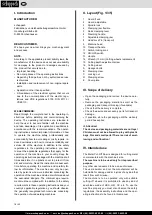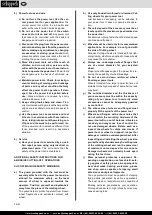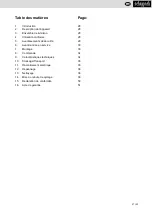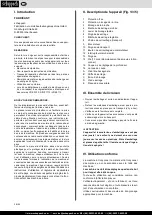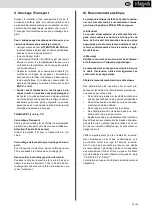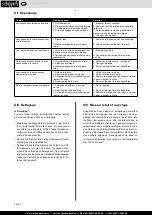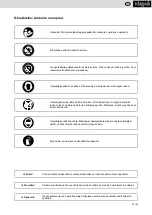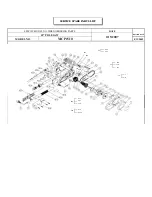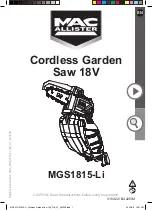
www.scheppach.com
+(49)-08223-4002-99
+(49)-08223-4002-58
23 І 52
Note:
The number of cuts per cutting-off wheel and
their quality may vary considerably with the time tak-
en to make the cuts. Fast cuts may accelerate wheel
wear, but they also prevent discoloring of the work-
piece and the formation of burr.
Quick clamping lever, Fig. 4
The machine is equipped with a quick clamping lever
(6).
Move the lever (6) up, push the clamping handle (5)
forward to the work-piece, push lever (6) down, after-
wards lock the work-piece using the clamping handle
(5).
Attention!
Prior to the cutting process, always check
that the work-piece is correctly and securely tight-
ened.
Long work-pieces must be supported by a dolly (roll-
ing support) or similar.
After work completion, place the machine head in the
lower position and pull out the mains plug.
Setting the Cutting wheel depth gauge
The cutting depth of the abrasive Cutting wheel can
be set using the depth cut adjustment screw (15).
Using ring spanner (14), loosen the jam nut.
Adjust the screw counterclockwise to increase the
depth of cut. Tighten the jam nut.
Adjust the screw clockwise to reduce the depth of cut.
Tighten the jam nut.
IX. Technical data
Dimensions L x W x H mm
580 x 310 x 400
Cutting wheel Ø/mm
355 x 25.4 x 3.2
Rated no-load speed 1/min
3000
Weight kg
20
Details for cutting
Workpiece min. mm
ø15 or 15x15
Workpiece max. mm
ø 100 or 230x50
Drive
Motor V~/Hz
230-240/50
Input power P1 / Watt
2000
Noise
Sound values were measured in accordance with EN
3744 / EN 11201.
Sound pressure level L
pA
94.3 dB(A)
Uncertainty K
pA
3 dB
Sound power level L
WA
107.3 dB(A)
Uncertainty K
WA
3 dB
Vibration
2.5
m/s
2
Uncertainty K
1.5
m/s
2
Wear ear-muffs.
The impact of noise can cause damage to hearing.
Lower the saw head (9) to check whether the cutting
wheel (16) reaches the clamping jaw (7) of the vice.
Retighten the lock nut.
Replacing the cutting-off wheel (See Fig. 5/6)
Pull out the power plug.
Move the machine head (9) to its upper position of
rest.
Swing up the adjustable guard (2) for the cutting-off
wheel and hook it in place by hand.
Open the nut (C) and turn the side guard (E) for the
cutting-off wheel to the rear.
Push the spindle lock (3) to the right and turn the cut-
ting wheel (16) slowly with the other hand until the
spindle lock (3) engages.
Use the supplied wrench (14) to turn out the shaft
screw (D) counterclockwise.
Remove the shaft screw (D), washer, outer flange and
worn cutting-off wheel (16). see Fig.5-6
Install the new cutting-off wheel in reverse order and
tighten.
Important!
The parts under the screw (D) have to be
thoroughly cleaned prior to mounting the cutting-off
wheel.
Note the direction arrow!
Use only recommended, reinforced cutting-off
wheels and take care to tighten the shaft screw (D)
just enough to hold the wheel (16) securely in place
and prevent it from spinning. Over-tightening the
shaft screw (D) may damage the cutting-off wheel.
Turn the side guard (E) for the cutting-off wheel back
to the front and fasten in place with the nut (C).
Unhook the guard for the cutting-off wheel, so that
the adjustable guard (2) can be flipped forward again.
VIII. Operation
ON/OFF-switch (See Fig. 1)
Press the lock button (11) and the ON/OFF-switch
(12) to turn on the saw.
To deactivate the cut-off saw again, let go off switch
(12).
Making a cut (See Fig. 3/4)
Clamp the workpiece securely in the vice.
Switch on the machine and wait for the motor to reach
its top speed.
Push down the machine head (9) by the handle (13)
until the cutting-off wheel makes slight contact with
the workpiece.
Move the cutting wheel (16) smoothly through the ma-
terial you want to cut.
Important!
Avoid causing the cutting-off wheel to
jump or chatter. This will only result in cuts of poor
quality or a broken wheel.
Press down the handle (13) firmly and evenly during
the cutting operation.
To prevent overheating of the workpiece and ex-
cessive formation of burr, you should not reduce
cutting speed at the end of the cutting operation.
GB










